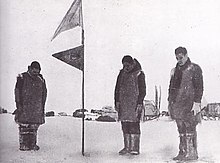Shirase Nobu
Shirase Nobu ( Japanese 白 瀬 矗 ; * July 20, 1861 ( traditionally : Bunkyū 1/6/13) in Konoura , Yuri-gun (today: Nikaho ), Akita Prefecture ; † September 4, 1946 in Koromo , Nishikamo-gun ( today: Toyota ), Aichi Prefecture) was a Japanese army officer who led the Japanese Antarctic Expedition 1910–1912 and met the Amundsen team . Shirase and his people first entered the Edward VII Peninsula and were hailed as heroes upon their return in Japan.
Shirase Nobu's first expedition took him to the Kuril Islands , north of Japan, in 1893 . As an unknown lieutenant in the army, he applied to conduct the Japanese Antarctic Expedition, with the support of former Prime Minister of Japan Ōkuma Shigenobu . The Antarctic expedition set sail in Tokyo on December 1, 1910 with the Kainan Maru ( 開 南 丸 ), a small sailing ship only 100 feet (30 meters) long. To say goodbye, only a few students gathered at the drop-off point. They reached Wellington , New Zealand on February 7, 1911 and set off for Antarctica four days later. Due to the bad weather with storms, heavy snowfall and the formation of pack ice, Shirase returned to Australia, where he landed in Sydney on May 1, 1911. There the Japanese had no financial means and little food, lived in poor conditions, camped in a hut and received derisive comments from the press. Part of the crew including the captain returned to Japan to raise funds. Professor Edgeworth David of the University of Sydney , a former member of Ernest Shackleton's Nimrod Expedition in 1907-1909, not only helped Shirase and his crew, but also advocated the Japanese among the Australian public.
Shirase knew he couldn't reach the South Pole before Roald Amundsen and Robert Scott . Nevertheless, it started again from Sydney on November 19, 1911, heading south and reached the Ross Ice Shelf on January 16, 1912 . At the Kainan Bay he had named , they met the Fram , Amundsen's ship, waiting for his return. Due to language problems, they could barely communicate.
The expedition later landed in the Bay of Whales on one of the huge ice fields and a group of seven men were dispatched, two of whom set up a base camp at the end of the ice field. The other five made further inquiries. After 160 miles, they gave up due to a blizzard and dwindling strength from their crew and sled dogs, stuck a Japanese flag in the ice on January 29 and returned to the ship. This area at 80 ° 5 ′ S , 156 ° 37 ′ W they called the Yamato Snow Field ( 大 和 雪原 , Yamato yukihara ). While Shirase was traveling with the group, the Kainan Maru left the Bay of Whales in the direction of Biscoe Bay to King Edward VII Land to explore the country there. She did not resume the group until February 2, and the crew returned to Yokohama via Wellington on June 20, 1912 . They had achieved all of their goals except the South Pole. When they arrived in Japan, they were hailed as heroes.
The total cost of Shirase was about 120,000–125,000 yen , and despite donations, he was in debt of 40,000 yen (now: 200 million yen). He paid for this by giving lectures all over Japan.
He died of intestinal obstruction on September 4, 1946 in Koromo (now Toyota ) . The Shirase Glacier , the Shirase Coast and the Shirase Bank off the coast are named in his honor in Antarctica .
Web links
- Biography of Nobu Shirase on www.south-pole.com
- Japanese Story of Polar Trip , reported in The New York Times, March 25, 1912
- Photo of the expedition members
Individual evidence
- ↑ a b c d 白 瀬 隊 の 紹 介 . (No longer available online.) In: 白 瀬 南極 探 検 隊 記念 館 公式 ホ ー ム ペ ー ジ (German: "Official homepage of the Shirase Antarctic Expedition Memorial"). Shirase Antarctic Expedition Memorial, Nikaho City, archived from the original on January 10, 2010 ; Retrieved September 22, 2009 (Japanese). Info: The archive link was inserted automatically and has not yet been checked. Please check the original and archive link according to the instructions and then remove this notice.
- ↑ a b c Biography of Nobu Shirase on www.south-pole.com
- ↑ “ The New Zealand Times was particularly poignant in its comments upon us. It remarked that we were a crew of gorillas sailing about in a miserable whaler, and that the polar regions were no place for such beasts of the forest as we. The zoological classification of us was perhaps to be taken figuratively, but many islanders interpreted it literally, because crowds of people came to our tents daily to observe the 'sporty gorillas' misguided with the crazy notion of conquering the South Pole. ” Www.south-pole.com
| personal data | |
|---|---|
| SURNAME | Shirase, Nobu |
| ALTERNATIVE NAMES | 白 瀬 矗 (Japanese) |
| BRIEF DESCRIPTION | Japanese officer and polar explorer |
| DATE OF BIRTH | July 20, 1861 |
| PLACE OF BIRTH | Konoura, Yuri-gun (now Nikaho), Akita Prefecture, Japan |
| DATE OF DEATH | September 4, 1946 |
| Place of death | Koromo , Nishikamo-gun (now Toyota), Aichi Prefecture |


